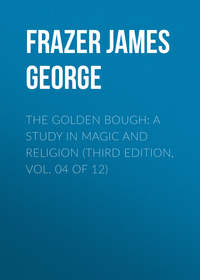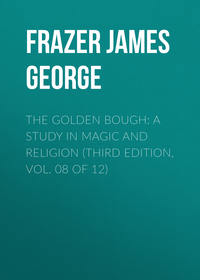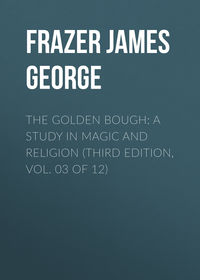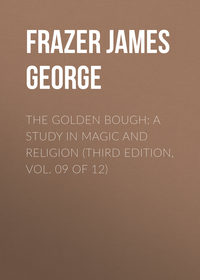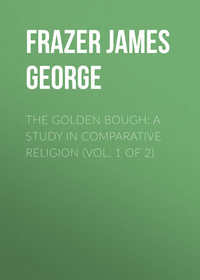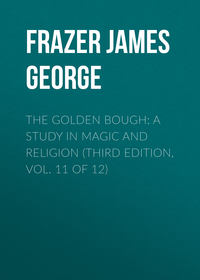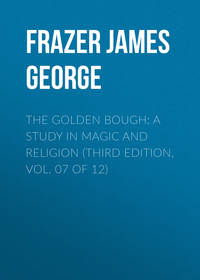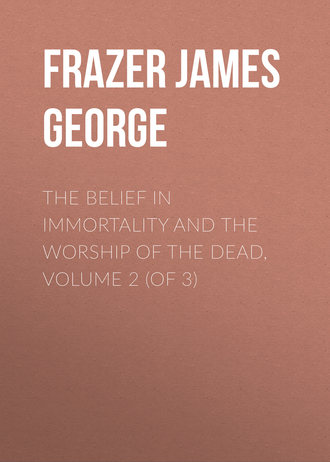 полная версия
полная версияThe Belief in Immortality and the Worship of the Dead, Volume 2 (of 3)
The grave of a chief's family was a vault paved with a single large stone, while the four walls were formed each of a single block. The vault was about eight feet long, six feet broad, and eight feet deep, and was covered at the top by one large stone.339 So heavy was this covering stone that, as we have seen, from a hundred and fifty to two hundred men were required to lift and lower it.340 Mariner estimated that the family vault in which King Finow was interred was large enough to hold thirty bodies. When the king's corpse was being deposited in it, Mariner saw two dry and perfectly preserved bodies lying in the vault, together with the bones of several others; and he was told by old men that the well-preserved bodies had been buried when they, his informants, were boys, which must have been upwards of forty years before; whereas the bodies of which nothing but the bones remained had been buried later. The natives attributed the exceptional preservation of the two to the better constitution of their former owners; Mariner, or more probably his editor, Dr. Martin, preferred to suppose that the difference was due to the kind or duration of the disease which had carried them off. Apparently the natives did not suggest that the bodies had been embalmed, which they would almost certainly have done if they had known of such a custom.341 No sooner was the king's body deposited in the grave, and the great stone lowered over it, than certain ministers (matabooles) and warriors ran like men frantic round and round the burial-ground, exclaiming, "Alas! how great is our loss! Finow! you are departed; witness this proof of our love and loyalty!" At the same time they cut and bruised their own heads with clubs, knives, and axes in the usual fashion.342 Afterwards the grave was filled up with earth and strewed with sand, which a company of women and men had brought for the purpose in baskets from a place at the back of the island; what remained of the sand was scattered over the sepulchral mound (fytoca), of which it was deemed a great embellishment. The inside of the burial-ground was then spread with mats made of coco-nut leaves.343
Meantime the company of mourners had been seated on the green before the burial-ground, still wearing their mourning garb of mats, with leaves of the ifi tree strung round their necks. They now arose and went to their homes, where they shaved their heads and burnt their cheeks with a lighted roll of bark-cloth, by applying it once upon each cheek-bone; next they rubbed the place with an astringent berry, which caused it to bleed, and afterwards they smeared the blood in a broad circle round the wound, giving themselves a very ghastly appearance. They repeated this friction with the berry every day, making the wound bleed afresh; and the men meanwhile neglected to shave and to oil themselves during the day, though they indulged in these comforts at night. Having burnt their cheeks and shaved their heads, they built for themselves small temporary huts, where they lived during the time of mourning, which lasted twenty days.344
The women who had become tabooed, that is, in a state of ceremonial pollution, by touching the king's dead body, remained constantly within the burial-ground for the twenty days of mourning, except when they retired to one of the temporary huts to eat,345 or rather to be fed by others. For it was a rule that no ordinary person, man or woman, could touch a dead chief without being tabooed, that is ceremonially polluted, for ten lunar months, during which time he or she might not touch food with their own hands. But for chiefs the period of pollution was limited to three, four, or five months, according to the superiority of the dead chief. Only when the dead body which they had touched was that of the sacred chief, the Tooitonga, they were all tabooed for ten months, however high their rank; for example, the king's wife was tabooed for that length of time during the residence of Mariner, because she had touched the dead body of the Tooitonga. During the time that a person was tabooed, he might not feed himself with his own hands, but must be fed by somebody else: he might not even use a toothpick himself, but might guide another person's hand holding the toothpick. If he was hungry and had no one to feed him, he must go down on his hands and knees, and pick up his victuals with his mouth; and if he infringed any of these rules, it was firmly expected that he would swell up and die.346 Captain Cook observed this custom in operation at Tongataboo. On one of his walks he met with a party of women at supper, and noticed that two of them were being fed by others. On asking the reason, he was answered taboo mattee, that is, "Death taboo." It was explained to him that one of the women had washed the dead body of a chief two months before, and that consequently she might not handle any food for five months. The other had performed the same office for the corpse of another person of inferior rank, and was now under the same restriction, but not for so long a time.347 The tabooed women at Finow's grave were supplied with food by the new king, Finow the Second. The food was brought and placed on the ground at some distance from the grave, or else it was deposited before the temporary house to which the chief of the tabooed women retired to be fed. With the provisions was also sent every day a supply of torches to light up the burial-ground by night. The torches were held up by a woman of inferior rank, who, when she was tired, was relieved in her office by another. During the twenty days of mourning, if any one passed the burial-ground, he had to go at a slow pace, with his head bowed down, and his hands clasped before him; and if he carried a burden, he must lower it from his shoulder and carry it in his hands or on his bended arms; but if he could not do so conveniently, he had to make a circuit to avoid the grave.
Such were the regular observances at the death and burial of chiefs; they were not peculiar to the obsequies of Finow the king.348
The twentieth day of mourning concluded the ceremonies in honour of the deceased monarch. Early in the morning all his relations, together with the members of his household, and also the women who were tabooed on account of having touched his dead body in the process of oiling and preparing it, went to the back of the island to procure a quantity of flat pebbles, principally white, but a few black, which they brought back in baskets to the grave. There they strewed the inside of the house and the outside of the burial-ground (fytoca) with the white pebbles as a decoration; the black pebbles they laid only on the top of those white ones which covered the ground directly over the body, to about the length and breadth of a man, in the form of a very eccentric ellipse. After that, the house on the burial mound was closed up at both ends with a reed fencing, which reached from the eaves to the ground; while at the front and the back the house was closed with a sort of basket-work, made of the young branches of the coco-nut tree, split and interwoven in a very curious and ornamental way. These fences were to remain until the next burial, when they would be taken down and, after the conclusion of the ceremony, replaced by new ones of similar pattern. A large quantity of food and kava was now sent by the chiefs and the king to the public place (malai) in front of the burial mound, and these provisions were served out among the people in the usual way. The company then separated and repaired to their respective houses, to prepare for the dances and the grand wrestling-match, which were to conclude the funeral rites.349
During the intervals of the dances, which followed, several warriors and ministers (matabooles) ran before the grave, cutting and bruising their heads with axes, clubs, and so forth as proofs of fidelity to their late chief, the dead and buried King Finow. It was on this occasion that the deceased king's fishermen demonstrated their loyalty and attachment to his memory by the self-inflicted tortures which I have already described.350 When these exhibitions of cruelty were over, the day's ceremonies, which altogether lasted about six hours, were terminated by a grand wrestling-match. That being over, the people dispersed to their respective houses or occupations, and the obsequies of Finow, king of the Tonga islands, came to an end.351
The wrestling-match which wound up the funeral honours paid to the departed monarch would seem not to have been an isolated case of athletic sports held at this particular funeral. Apparently it was a general custom in Tonga to conclude burial-rites with games of this kind. At least we may infer as much from an expression made use of by the first missionaries to Tongataboo. They say that the chief of their district, after taking to himself a wife in the morning went in the afternoon "to finish the funeral ceremonies for his brother, in celebrating the games usual on that occasion."352 The practice, which is apt to seem to us incongruous, of holding games at a funeral, was observed by the Greeks in antiquity and by not a few other peoples in modern times.353
On the other hand the obsequies of the sacred or divine chief, the Tooitonga, differed in certain remarkable particulars from the posthumous honours generally paid to chiefs. It is true that his burial-place was of the same form as that of other chiefs, and that the mode of his interment did not differ essentially from theirs, except that it was customary to deposit some of his most valuable property with him in the grave, including his beads, whale's teeth, fine Samoan mats, and other articles. Hence the family burying-place of the Tooitongas in the island of Tongataboo, where the whole line of these pontiffs had been interred, must have become very rich in the course of time; for no native would dare to commit the sacrilege of stealing the treasures at the holy tomb.354 However, the sacrifice of property to the dead seems not to have been, as Mariner supposed, peculiar to the funeral of the Tooitonga; for at the burial of King Moomōoe, in May 1797, the first missionaries saw files of women and men bringing bags of valuable articles, fine mats, and bales of cloth, which they deposited in the tomb expressly as a present for the dead.355 Again, the mourning costume worn for the Tooitonga was the same as that for any chief, consisting of ragged old mats on the body and leaves of the ifi tree round the neck; but in the case of the Tooitonga the time of mourning was extended to four months, the mats being generally left off after three months, while the leaves were still retained for another month; and the female mourners remained within the burial-ground (fytoca, fiatooka) for about two months, instead of twenty days, only retiring occasionally to temporary houses in the neighbourhood to eat or for other necessary purposes.356
One very remarkable peculiarity in the mourning for a Tooitonga was that, though he ranked above the king and all other chiefs, the mourners strictly abstained from manifesting their grief by wounding their heads and cutting their bodies in the manner that was customary at the funerals of all other great men. Mariner was never able to learn the reason for this abstention.357
Other peculiar features in the obsequies of a Tooitonga were the following. In the afternoon of the day of burial, when the body of the Tooitonga was already within the burial-ground, almost every man, woman, and child, all dressed in the usual mourning garb, and all provided with torches, used to sit down about eighty yards from the grave; in the course of an hour a multitude of several thousands would thus assemble. One of the female mourners would then come forth from the burial-ground and call out to the people, saying, "Arise ye, and approach"; whereupon the people would get up, and advancing about forty yards would again sit down. Two men behind the grave now began to blow conch-shells, and six others, with large lighted torches, about six feet high, advanced from behind the burial-ground, descended the mound, and walked in single file several times between the burial-ground and the people, waving their flaming torches in the air. After that they began to ascend the mound, whereupon all the people rose up together and made a loud crashing noise by snapping their bolatas, which were pieces of the stem of a banana tree used to receive the ashes falling from lighted torches. Having done so, the people followed the torch-bearers in single file up the mound and walked in procession round about the tomb (fytoca). As they passed at the back of the tomb, they all, torch-bearers and people, deposited their extinguished torches on the ground; while the female mourners within thanked them for providing these things. Having thus marched round, the people returned to their places and sat down. Thereupon the master of the ceremonies came forward and ordered them to divide themselves into parties according to their districts; which being done he assigned to one party the duty of clearing away the bushes and grass from one side of the grave, and to another party a similar task in regard to another side of the grave, while a third party was charged to remove rubbish, and so forth. In this way the whole neighbourhood of the burial-ground was soon cleared, and when this was done, all the people returned to the temporary houses which, as mourners, they were bound to occupy.358
Soon after darkness had fallen, certain persons stationed at the grave began again to sound the conches, while others chanted a song, or rather recitative, partly in the Samoan dialect, partly in an unknown language, of which the natives could give no account. None of them understood the words, nor could they explain how their forefathers came to learn them. All that they knew was that the words had been handed down from father to son among the class of people whose business it was to direct burial ceremonies. According to Mariner, some of the words were Tongan, and he thought that the language was probably an old or corrupt form of Tongan, though he could make no sense out of it. Such traditional repetition of a litany in an unknown tongue is not uncommon among savages; it occurs, for instance, very frequently among some of the aboriginal tribes of Australia, where the chants or recitatives accompanying certain dances or ceremonies are often passed on from one tribe to another, the members of which perform the borrowed dance or ceremony and repeat by rote the borrowed chants or recitatives without understanding a word of them.359
While the conches were sounding and the voices of the singers broke the silence of night, about sixty men assembled before the grave, where they awaited further orders. When the chanting was over, and the notes of the conches had ceased to sound, one of the women mourners came forward, and sitting down outside the graveyard addressed the men thus: "Men! ye are gathered here to perform the duty imposed on you; bear up, and let not your exertions be wanting to accomplish the work." With these words she retired into the burial-ground. The men now approached the mound in the dark, and, in the words of Mariner, or his editor, performed their devotions to Cloacina, after which they withdrew. As soon as it was daylight the next morning, the women of the first rank, wives and daughters of the greatest chiefs, assembled with their female attendants, bringing baskets and shells wherewith to clear up the deposit of the preceding night; and in this ceremonious act of humility no lady of the highest rank refused to take her part. Some of the mourners in the burial-ground generally came out to assist, so that in a very little while the place was made perfectly clean. This deposit was repeated the fourteen following nights, and as punctually cleared away by sunrise every morning. No persons but the agents were allowed to be witnesses of these extraordinary ceremonies; at least it would have been considered highly indecorous and irreligious to pry upon them. On the sixteenth day, early in the morning, the same women again assembled, but now they were dressed in the finest bark-cloth and beautiful Samoan mats, decorated with ribbons and with wreaths of flowers round their necks; they also brought new baskets, ornamented with flowers, and little brooms very tastefully made. Thus equipped, they approached and acted as if they had the same task to perform as before, pretending to clear up the dirt, and to take it away in their baskets, though there was no dirt to remove. Then they returned to the capital and resumed their mourning dress of mats and leaves. Such were the rites performed during the fifteen days; every day the ceremony of the burning torches was also repeated.360
For one month from the day of burial, greater or less quantities of provisions were brought every day and shared out to the people. On the first day the quantity supplied was prodigious; but day by day the supply gradually diminished till on the last day it was reduced to very little.361 Nevertheless the consumption or waste of food on such occasions was so great that to guard against a future dearth of provisions it was deemed necessary to lay a prohibition or taboo on the eating of hogs, fowls, and coco-nuts for a period of eight or ten months, though two or three plantations were exempted from this rigorous embargo, to the end that in the meantime hogs, fowls, and coco-nuts might be furnished for occasional religious rites, and that the higher order of chiefs might be able to partake of these victuals. At the end of the eight or ten months' fast the taboo was removed and permission to eat of the forbidden foods was granted by the king at a solemn ceremony. Immense quantities of yams having been collected and piled up in columns, and some three or four hundred hogs having been killed, the people assembled from all quarters at the king's malái or public place. Of the slaughtered hogs about twenty were deposited, along with a large quantity of yams, at the grave of the deceased Tooitonga. The rest of the provisions were shared out in definite proportions among the gods, the king, the divine chief (the living Tooitonga), the inferior chiefs, and the people, so that every man in the island of Tongataboo got at least a mouthful of pork and yam. The ceremony concluded with dancing, wrestling, and other sports, after which every person retired to his home with his portion of food to share it with his family. The hogs and yams deposited at the dead Tooitonga's grave were left lying till the pork stank and the yams were rotten, whereupon the living Tooitonga ordered that they should be distributed to all who chose to apply for a portion. In strict law they belonged to the principal chiefs, but as these persons were accustomed to feed on meat in a rather less advanced stage of decomposition they kindly waived their claims to the putrid pork and rotten yams in favour of the lower orders, who were less nice in their eating.362
It was customary that the chief widow of the Tooitonga should be strangled and interred with his dead body.363 But the practice of strangling a wife at her husband's funeral was not limited to the widows of the Tooitongas. A similar sacrifice seems to have been formerly offered at the obsequies of a king; for at the funeral of King Moomöoe the first missionaries to Tonga saw two of the king's widows being led away to be strangled.364
The funeral and mourning customs which we have passed in review serve to illustrate the Tongan conceptions of the soul and of its survival after death. The strangling of widows was probably intended here as elsewhere to despatch their spirits to attend their dead husbands in the spirit land;365 and the deposition of valuable property in the grave can hardly have had, at least in origin, any other object than to ensure the comfort of the departed in the other world, and incidentally, perhaps, to remove from him any temptation to return to his sorrowing friends in this world for the purpose of recovering the missing articles. The self-inflicted wounds and bruises of the mourners were clearly intended to impress the ghost with the sincerity of their regret at his departure from this sublunary scene; if any doubt could linger in our minds as to the intention of these extravagant proceedings, it would be set at rest by the words with which, as we have seen, the mourners accompanied them, calling on the dead man to witness their voluntary tortures and to judge for himself of the genuineness of their sorrow. In this connexion it is to be borne in mind that all dead noblemen, in the opinion of the Tongans, were at once promoted to the rank of deities; so that it was in their power to visit any disrespect to their memory and any defalcation of their dues with the double terror of ghosts and of gods. No wonder that the Tongans sought to keep on good terms with such mighty beings by simulating, when they did not feel, a sense of the irreparable loss which the world had sustained by their dissolution.
§ 12. The Ethical Influence of Tongan Religion
Surveyed as a whole, the Tongan religion presents a singular instance of a creed which restricted the hope of immortality to the nobly born and denied it to commoners. According to the doctrine which it inculcated, the aristocratic pre-eminence accorded to chiefs in this world was more than maintained by them in the next, where they enjoyed a monopoly of immortality. And not content with sojourning in the blissful regions of Bolotoo, their departed spirits often returned to earth to warn, to direct, to threaten their people, either in dreams and visions of the night, or by the mouth of the priests whom they inspired. Such beliefs involved in theory and to some extent in practice a subjection of the living to the dead, of the seen and temporal to the unseen and eternal. In favour of the creed it may at least be alleged that, while it looked to spiritual powers, whether ghosts or gods, for the reward of virtue and the punishment of vice, it did not appeal to another life to redress the balance of justice which had been disturbed in this one. The Tongan religion inculcated a belief that the good and the bad alike receive a recompense here on earth, thus implicitly repudiating the unworthy notion that men can only be lured or driven into the narrow way of righteousness by the hope of heaven or the fear of hell. So far the creed based morality on surer foundations than any faith which would rest the ultimate sanctions of conduct on the slippery ground of posthumous rewards and punishments. In this respect, if in no other, we may compare the Tongan religion to that of the Hebrew prophets. It has been rightly observed by Renan that whereas European races in general have found in the assurance of a life to come ample compensation for the iniquities of this present life, the Hebrew prophets never appeal to rewards and punishments reserved for a future state of existence. They were not content with the conception of a lame and laggard justice that limps far behind the sinner in this world and only overtakes him in the next. According to them, God's justice is swift and sure here on earth; an unjust world was in their eyes a simple monstrosity.366 So too, apparently, thought the Tongans, and some Europeans may be inclined to agree with them.
CHAPTER III
THE BELIEF IN IMMORTALITY AMONG THE SAMOANS
§ 1. The Samoan Islands
About three hundred and fifty or four hundred miles nearly due north of Tonga lies Samoa, a group of islands situated between 13° 30' and 14° 30' South latitude and between 168° and 173° West longitude. The native name of the group is Samoa, which has this singularity, that it is apparently the only name that designates a group of islands in the Pacific; native names for all the other groups are wanting, though each particular island has its own individual name. Samoa is also known to Europeans as the Navigators' Islands, a name bestowed on them by the French explorer De Bougainville, who visited the group in 1768. The three most easterly islands were discovered in 1722 by Jacob Roggewein, a Dutch navigator, but he appears not to have sighted the principal islands of the group, which lie a good deal farther to the westward. There is no record of any visit paid by a European vessel to the islands in the interval between the visits of Roggewein and De Bougainville. The whole archipelago was not explored till 1787, when the French navigator La Pérouse determined the position of all the islands.367




